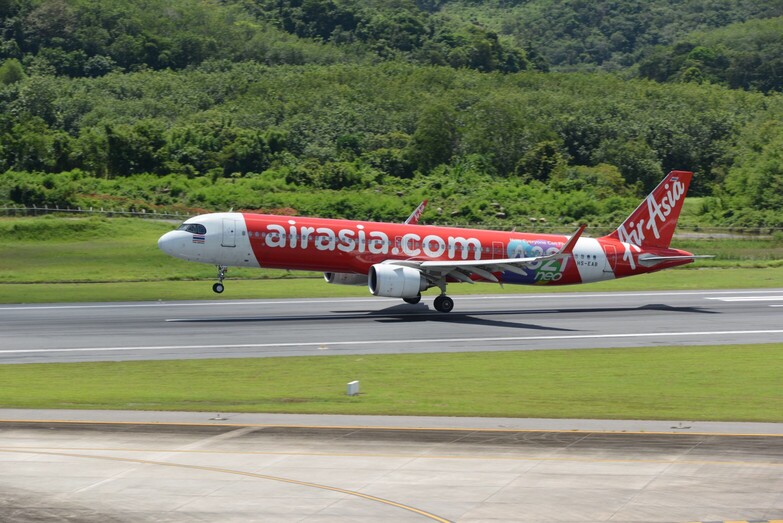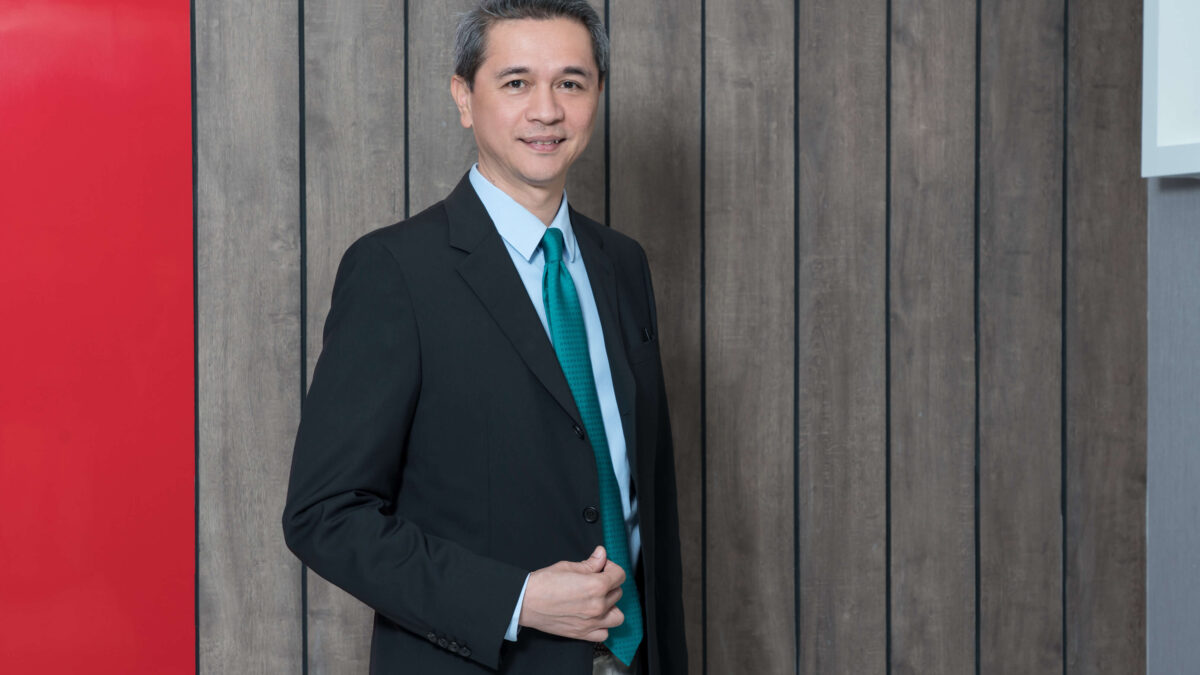INTERVIEW: Thai AirAsia Executive Chairman Tassapon Bijleveld On The Carrier’s Flights Through Unrelenting COVID-19 Storms
Thai AirAsia (TAA) is seeing green shoots for a turnaround after being struck severely by the catastrophic COVID-19 outbreak.
The prospects for recovery seem to be looming large as the largest no-frills carrier of Thailand is moving strenuously to jumpstart its flight operations which were largely ground to a halt for one and a half years due to the consequences of the disastrous economic fallout from the coronavirus.
In an interview with the Smart Aviation APAC, TAA executive chairman Tassapon Bijleveld sounded confident of the airline’s revival which he expects to emerge in the coming months as adverse effects from the pandemic are easing and its bid to reconsolidate its financial resources are materializing.
“The worst seems to be over as the circumstances surrounding us have progressively tackled in a way that allows us to get back on the business,” he says.
Central to TAA’s resurrection, as Tassapon points out, is the Thai government’s dramatic change of attitude towards the pandemic. The government has now opted for a ‘living with COVID-19’ approach whereas in the past it tried to eradicate the virus by imposing lockdowns and clamping down on air travel which in turn led to the widespread suspension of commercial flights.
The government has adopted its ‘learning to live with COVID-19’ approach even though a ferocious third wave has continued unabated in the country with cumulative case numbers and the death toll reaching 1.39 million and 14,485 respectively on 13 September according to Johns Hopkins University data.
The ‘learning to live Covid-19’ strategy, recognising the endemic nature of the virus in common with that of countries like the UK and Singapore, is steering Thai authorities away from wide-spread lockdowns that impedes air travel domestically and internationally.
Instead it is seeking restrictions on specific areas of infection and continuing to enforce restrictions already in place.
The vaccination rollouts are also gaining momentum in Thailand and worldwide, making the country feel emboldened to reopen to travellers in tandem with resumption of commercial flights, according to the TAA boss.
But authorities have taken a view that stringent measures to stem a tide of infections are still needed as the highly infectious delta variant has a much higher viral load and spreads faster.
The re-opening, which will occur in stages starting in October with popular tourist areas, is also aimed at reviving Thailand’s battered travel industry. The move comes after indicators suggest the number of new coronavirus infections may have peaked to warrant relaxation of some restrictions.
“The government has clearly realised that lockdowns are no longer applicable in the wake of the economy collapsing and the travel industry being decimated,” says Tassapon, adding “they need to allow people to travel again.”
Jumpstart
Beginning on 3 September, TAA resumed 11 domestic routes, using limited capacity, as Thai authorities began to ease some restrictions to allow resumption of domestic flights totally halted from 21 July to 31 August.
Tassapon made clear that the airline’s intention to expand domestic coverage in this year’s fourth quarter is in line with the re-opening policy.
TAA targets to have the domestic network restored entirely to the pre-COVID levels – 35 routes – by the first quarter of next year.
Tassapon says resumption of TAA’s overseas services, totally halted since April 2020, could restart by the end of 2022’s first quarter at the earliest, probably beginning with Hong Kong, Singapore and Macau under ‘travel bubble’ arrangements.
“We can’t rush to restore international flights as there are still uncertainties whether Thailand and those foreign countries would agree to re-establish the air link, subject to COVID-19 situations, the inoculation rates and travel sentiment,” he notes.
It is probably good enough to bring half of TAA’s pre-COVID international routes, numbering 59, back on line in 2022, he adds.
TAA has been operationally ready, throughout the difficult times, to support resumption of services. It has a 5,200-strong workforce including pilots, crew and engineers. Most are furloughed but are ready to report back to work, according to Tassapon.
The airline’s fleet of 60 single-aisle aircraft, comprising 47 Airbus A320s, 11 A320neos and two A321s, have also been retained, are regularly maintained and are in good operating condition for flying, he says.

New funds
TAA’s bid to secure new funds to shore up its liquidity has made headway.
The airline has obtained fresh capital injection from new investors and on 9 September launched a crowd-funding campaign in the form of debenture issuance.
Earlier this year, TAA set out to launch an initial public offering (IPO) as part of a corporate restructuring to stem the impact from the pandemic.
TAA has been working its own fund raisings as its request for soft loans from the government has shown no signs of being forthcoming. The request was first proposed one and a half year ago collectively by the Thailand Airlines Association though the overall amount requested by the airline members was subsequently reduced from 20 billion baht (US$610 million) to 15 billion baht and now five billion baht.
When Smart Aviation APAC spoke to Tassapon, he seemed resigned to not getting the loan, saying the load request is obstructed by bureaucracy and that the government does not take the matter seriously.
“It has been too long a wait. If finally the government would say ‘yes’, that’s fine, but we are better off finding our own means for the time being.”
While declining to go into details, Tassapon says new sources of funds, amounting to 5-6 billion baht, look set to be made available to TAA over the next 30-45 days, to help the airline regain its financial strength to pre-COVID levels.
Concerns
Top of his concerns are the depressed purchasing power of travellers as a result of the economic fallout from COVID. He says he is also concerned about higher costs to airlines, resulting from compliance of COVID-19 protection rules, putting upward pressure on air fares.
There are possibilities of the counter-COVID measures being toughened, which could then inadvertently lead to additional compliance costs to airlines.
TAA’s fares, averaging 1,478 baht (US$45) per sector in 2019, will be higher but are unlikely to be significantly more beyond an unacceptable level, he says.
Tassapon says consumer behaviour, with regard to travelling, may have changed due to the ‘new normal lifestyle’.
Ancillary
On parent AirAsia Group’s foray into the logistics business through the Teleport platform in Thailand, Tassapon sees it as part of the airline’s digital transformation and a move that provides new ancillary revenue streams to lessen Thai AirAsia’s reliance on its passenger business.
Through the AirAsia super app, the on-line service kicked off in Thailand in August with food delivery. Other services related to rides, express, beauty and groceries will start in the coming months.
Asked what he is expecting from the new businesses, he says: “We would be very happy if the Teleport operations contribute 15% to our revenue.”
Turnaround
Tassapon describes it as a tough question as to when TAA – which posted a total net loss of 8.82 billion baht from January 2020 to June 2021 through its listed parent firm, Asia Aviation – would turn its balance sheet around.
“If the pace of recovery is as strong as hoped for, we could move away from the red zone to breakeven next year and post profits a year later.”
The question of TAA expanding its fleet is irrelevant for several years from now, says Tassapon, adding that the focus now is to make use of the capacity of the current fleet.
“That is the question for the next three to four years,” he says, noting that only five to six of its 60 aircraft fleet are in use.
On the possibilities of TAA moving into the cargo business with a dedicated operation and freighters, Tassapon says that is not on the radar screen.
“The passenger side of the airline business will remain as TAA’s mainstay and other ventures, like Teleport, will function as auxiliary units.”
Thai language version of article:
สัมภาษณ์: ธรรศพลฐ์ แบเลเว็ลด์ ประธานกรรมการบริหาร ไทยแอร์เอเชีย ถึงการฟันฝ่าพายุโควิด-19 ที่โหมอย่างไม่หยุดยั้ง
โดย บุญส่ง โฆษิต
ไทยแอร์เอเชีย ได้เริ่มเห็นการฟื้นตัว หลังได้รับผลกระทบจากการระบาดของโควิด-19 อย่างรุนแรง
แนวโน้มการฟื้นตัวดูเหมือนเด่นชัดมากขึ้น เนื่องจากสายการบินต้นทุนต่ำที่ใหญ่ที่สุดของประเทศไทย กำลังดำเนินการอย่างแข็งขันเพื่อกลับมาทำการบิน ซึ่งส่วนใหญ่ต้องหยุดชะงักเป็นเวลากว่า หนึ่งปี กับหกเดือน อันเนื่องมาจากผลที่ตามมาของภัยพิบัติทางเศรษฐกิจจาก ไวรัสโคโรน่า
ในการให้สัมภาษณ์กับ สมาร์ทเอวิเอชั่น เอแพค (Smart Aviation APAC) ธรรศพลฐ์ แบเลเว็ลด์ ประธานกรรมการบริหาร ไทยแอร์เอเชีย ได้แสดงความมั่นใจถึงการฟื้นตัวของสายการบิน ซึ่งเขาคาดว่าจะเกิดขึ้นในอีกไม่กี่เดือนข้างหน้า เนื่องจากผลกระทบจากโรคระบาดกำลังคลี่คลายลง และความพยายามในการเสริมสร้างทรัพยากรทางการเงินให้กลับคืนมาได้เห็นเป็นรูปธรรม
“สิ่งที่เลวร้ายที่สุดดูเหมือนจะผ่านพ้นไปแล้ว เนื่องจากสถานการณ์รอบตัวเราค่อยๆ ถูกจัดการในลักษณะที่ช่วยให้เราสามารถกลับไปทำธุรกิจได้” เขากล่าว
เหตุผลหลักของการฟื้นคืนชีพของ ไทยแอร์เอเชีย ตามที่ธรรศพลฐ์ชี้ให้เห็นคือทัศนคติที่เปลี่ยนไปอย่างมากของรัฐบาลไทยต่อการระบาดใหญ่ โดยขณะนี้รัฐบาลได้เลือกใช้แนวทางที่จะ อยู่ร่วมกับ ไวรัสโควิด-19 จากที่ในอดีต รัฐบาลได้พยายามกำจัดการติดเชื้อโดยการล็อกดาวน์ และจำกัดการเดินทางทางอากาศ ซึ่งนำไปสู่การระงับเที่ยวบินเชิงพาณิชย์ในวงกว้าง
รัฐบาลได้นำแนวทาง ที่เรียกว่า ‘เรียนรู้ที่จะอยู่กับโควิด-19’ มาใช้ แม้ว่าคลื่นลูกที่สามของเชื้อโรคที่รุนแรงในประเทศยังคงไม่ลดละ โดยมีจำนวนผู้ป่วยสะสมและผู้เสียชีวิตถึง 1.39 ล้านคนและ 14,485 รายตามลำดับ ในวันที่ 13 กันยายน ตามข้อมูลของมหาวิทยาลัยจอห์น ฮอปกินส์
กลยุทธ์ ‘เรียนรู้ที่จะใช้ชีวิตอยู่กับโควิด-19’ ได้ตระหนักถึงธรรมชาติของไวรัสในนิยามใหม่ว่า เป็นโรคที่เกิดเฉพาะถิ่น เฉกเช่นเดียวกับแนวคิดในประเทศต่างๆ เช่น สหราชอาณาจักร และสิงคโปร์ และกำลังขับเคลื่อนทางการไทยให้ห่างไกลจากการ ล็อกดาวน์ในวงกว้าง ที่ขัดขวางการเดินทางทางอากาศทั้งในประเทศและต่างประเทศ แบบที่เคยปฏิบัติ แต่เป็นการแสวงหาข้อจำกัดในพื้นที่เฉพาะของการติดเชื้อ และดำเนินการบังคับใช้ข้อจำกัด ที่มีอยู่แล้วต่อไป
ในขณะเดียวกัน ได้มีการเร่งรัดการฉีดวัคซีนทั้งในประเทศไทย และทั่วโลก ทำให้ประเทศไทยรู้สึกกล้าที่จะเปิดให้การบริการอีกครั้งสำหรับนักเดินทาง ควบคู่ไปกับการเริ่มต้นเที่ยวบินเชิงพาณิชย์ ธรรศพลฐ์กล่าว
อย่างไรก็ตาม ทางราชการมองว่ายังจำเป็นต้องมีมาตรการที่เข้มงวด เพื่อยับยั้งกระแสของการติดเชื้อ เนื่องจากไวรัสกลายพันธุ์ เดลต้า ที่แพร่อยู่นี้ มีปริมาณไวรัสที่สูงกว่ามากและแพร่กระจายได้เร็วกว่า
การเปิดประเทศอีกครั้ง ซึ่งจะเกิดขึ้นในระยะเริ่มต้นในเดือนตุลาคมในแหล่งท่องเที่ยวยอดนิยม มีเป้าหมายเพื่อฟื้นฟูอุตสาหกรรมการท่องเที่ยวของประเทศไทยที่ทรุดโทรม และ การเคลื่อนไหวดังกล่าวเกิดขึ้นหลังจากตัวชี้วัดบ่งชี้ว่าจำนวนผู้ติดเชื้อ ใหม่อาจถึงจุดสูงสุดแล้ว ทำให้การผ่อนคลายข้อจำกัดบางอย่างเป็นไปได้
“รัฐบาลตระหนักดีว่าการล็อกดาวน์ใช้ไม่ได้อีกต่อไป หลังจากเศรษฐกิจถดถอยและอุตสาหกรรมการท่องเที่ยวถูกทำลาย” ธรรศพลฐ์ กล่าว และเสริมว่า “พวกเขาควรปล่อยให้ผู้คนเดินทางได้อีกครั้ง”
เริ่มต้นใหม่
ตั้งแต่วันที่ 3 กันยายนเป็นต้นมา ไทยแอร์เอเชียได้กลับมาให้บริการเส้นทางภายในประเทศ 11 เส้นทาง โดยใช้ความจุที่จำกัด หลังจากที่ทางการไทยเริ่มผ่อนปรนข้อจำกัดบางประการเพื่อให้เที่ยวบินภายในประเทศ ที่ได้หยุดทั้งหมด ตั้งแต่วันที่ 21 กรกฎาคม ถึง 31 สิงหาคม กลับมาดำเนินการได้
ธรรศพลฐ์แสดงอย่างชัดเจนว่า ไทยแอร์เอเชียตั้งใจที่จะขยายพื้นที่ให้บริการภายในประเทศต่อไปในไตรมาสที่ 4 ของปีนี้ สอดคล้องกับนโยบายการเปิดให้บริการอีกครั้ง โดยตั้งเป้าให้เครือข่ายภายในประเทศกลับสู่ระดับก่อนโควิด-19 ทั้งหมด – 35 เส้นทาง – ภายในไตรมาสแรกของปีหน้า
เขากล่าวว่าการบริการเที่ยวบินระหว่างประเทศของไทยแอร์เอเชีย ซึ่งหยุดลงอย่างสิ้นเชิงตั้งแต่เดือนเมษายนปีนี้ จะสามารถเริ่มต้นใหม่ได้ภายในสิ้นไตรมาสแรกของปี 2565 อย่างเร็วที่สุด โดยอาจเริ่มต้นที่ฮ่องกง สิงคโปร์ และมาเก๊า ภายใต้ข้อตกลง ‘travel bubbles’
“เราไม่สามารถเร่งรัดฟื้นฟูเที่ยวบินระหว่างประเทศได้ เนื่องจากยังมีความไม่แน่นอนว่าไทยและต่างประเทศจะตกลงที่จะสร้างการเชื่อมโยงทางอากาศขึ้นใหม่หรือไม่ ขึ้นอยู่กับสถานการณ์โควิด-19 อัตราการฉีดวัคซีน และอารมณ์การเดินทาง” เขากล่าว
ธรรศพลฐ์กล่าวเสริมว่า น่าจะดีพอที่จะนำเส้นทางระหว่างประเทศซักครึ่งหนึ่งของ 59 เส้นทางที่บินอยู่ ช่วงก่อนโควิด-19 กลับมาบริการอีกครั้ง ในปี 2565
ทางไทยแอร์เอเชียได้เตรียมพร้อมในการดำเนินงานตลอดช่วงเวลาที่ยากลำบาก เพื่อรองรับการกลับมาให้บริการอีกครั้ง มีพนักงานที่แข็งแกร่งกว่า 5,200 คน รวมทั้งนักบิน ลูกเรือ และวิศวกร ส่วนใหญ่พักงานแต่พร้อมกลับมารายงานตัวเข้าทำงาน
นอกจากนี้ ฝูงบินเครื่องบินทางเดินเดี่ยวจำนวน 60 ลำของสายการบิน ซึ่งประกอบด้วย A320 จำนวน 47 ลำ, A320neos 11 ลำ และ A321 อีก 2 ลำ ได้รับการบำรุงรักษาไว้อย่างสม่ำเสมอ และอยู่ในสภาพใช้งานได้ดีสำหรับการบิน
แหล่งเงินทุนใหม่
เขากล่าวว่าความพยายามในการจัดหาเงินทุนใหม่เพื่อเสริมสภาพคล่องได้คืบหน้า โดยสายการบินได้รับการอัดฉีดทุนใหม่จากนักลงทุนรายใหม่ และเมื่อวันที่ 9 กันยายน ได้เปิดตัวการระดมทุนออกหุ้นกู้คราวด์ฟันดิง (Crowdfunding)
เมื่อต้นปีนี้ ไทยแอร์เอเชียได้เริ่มการเสนอขายหุ้นแก่ประชาชนทั่วไป (IPO) อันเป็นส่วนหนึ่งของการปรับโครงสร้างองค์กรเพื่อสกัดกั้นผลกระทบจากการระบาดใหญ่
ไทยแอร์เอเชียได้ดำเนินการระดมทุนของตนเอง เนื่องจากการขอสินเชื่อผ่อนปรน (soft loan) จากรัฐบาลไม่ได้แสดงสัญญาณที่จะเกิดขึ้น
คำขอนี้ถูกเสนอครั้งแรกต้นปีที่แล้ว โดยสมาคมการบินแห่งประเทศไทย แม้ว่าจำนวนเงินทั้งหมดที่ร้องขอโดยสมาชิกเจ็ดสายการบินในเวลาต่อมาลดลงจาก สองหมื่นล้านบาท (610 ล้านเหรียญสหรัฐ) เป็น 1.5 หมื่นล้านล้านบาท และตอนนี้ 5 พันล้านบาท
เมื่อสมาร์ทเอวิเอชั่น เอแพค ถามถึงประเด็นนี้ ธรรศพลฐ์ ดูเหมือนว่าได้ถอดใจว่าคงจะไม่ได้รับเงินกู้นี้ โดยกล่าวว่าคำขอถูกขัดขวางจากระบบราชการ และรัฐบาลก็ไม่ได้ดำเนินการเรื่องนี้อย่างจริงจัง
“เรารอนานเกินไปแล้ว ถ้าในที่สุดรัฐบาลจะตอบว่า ‘ใช่’ ก็ดี แต่ในขณะนี้เราควรหาหนทางของตัวเองดีกว่า”
ขณะที่ปฏิเสธที่จะลงรายละเอียด เขากล่าวว่าแหล่งเงินทุนใหม่มูลค่า 5-6 พันล้านบาทคงจะเริ่มไหลเข้ามาสู่บริษัท ในอีก 30-45 วันข้างหน้า เพื่อช่วยให้สายการบินฟื้นความแข็งแกร่งทางการเงินอีกครั้งเช้าสู่ในระดับ ก่อนโควิด-19
ความกังวล
สิ่งที่เขากังวลมากที่สุดคือกำลังซื้อที่ตกต่ำของนักเดินทาง ซึ่งเป็นผลมาจากผลกระทบทางเศรษฐกิจจากโควิด เขากล่าวว่าเขายังมีความกังวลเกี่ยวกับค่าใช้จ่ายที่สูงขึ้นสำหรับสายการบิน ซึ่งเป็นผลมาจากการปฏิบัติตามกฎการป้องกันโควิด ซึ่งทำให้แรงกดดันด้านค่าโดยสารสูงขึ้น
มีความเป็นไปได้ที่มาตรการต่อต้านโควิด-19 จะเข้มงวดขึ้น ซึ่งอาจนำไปสู่ค่าใช้จ่ายเพิ่มเติมในการปฏิบัติตามข้อกำหนด สำหรับสายการบินโดยไม่ได้ตั้งใจ
ค่าโดยสารของไทยแอร์เอเชีย โดยเฉลี่ยอยู่ที่ 1,478 บาท (45 เหรียญสหรัฐ) ต่อเซกเตอร์ในปี 2562 จะสูงขึ้นในอนาคต แต่ไม่น่าจะเกินระดับที่ยอมรับไม่ได้อย่างมีนัยสำคัญ เขากล่าว
พฤติกรรมผู้บริโภคในเรื่องการเดินทางอาจเปลี่ยนไปเนื่องจาก ‘วิถีการดำเนินชีวิตแบบปกติใหม่’ หรือ New Normal
ธุรกิจเสริม
จากการที่กลุ่มบริษัทแม่แอร์เอเชียรุกเข้าสู่ธุรกิจโลจิสติกส์ผ่านแพลตฟอร์มเทเลพอร์ต (Teleport) ในประเทศไทย ธรรศพลฐ์มองว่าเป็นส่วนหนึ่งของการเปลี่ยนแปลงทางดิจิทัลของสายการบิน และการเคลื่อนไหวที่จะสร้างกระแสรายได้เสริมใหม่เพื่อลดการพึ่งพาธุรกิจผู้โดยสารของไทยแอร์เอเชีย
โดยผ่านแอพ AirAsia Super App การบริการออนไลน์เริ่มต้นในประเทศไทยในเดือนสิงหาคมด้วยการจัดส่งอาหาร บริการอื่นๆ ที่เกี่ยวข้องกับการโดยสาร รถด่วน ความงาม และของชำ จะเริ่มในอีกไม่กี่เดือนข้างหน้า
เมื่อถูกถามถึงสิ่งที่เขาคาดหวังจากธุรกิจใหม่ เขากล่าวว่า “เราจะมียินดีมากถ้าการดำเนินการเทเลพอร์ตจะมีส่วนทำให้รายได้ของเราเป็น 15% ของทั้งหมด”
งบการเงิน
ธรรศพลฐ์ว่าเป็นคำถามที่ยากที่จะตอบว่าเมื่อไร ไทยแอร์เอเชีย ซึ่งขาดทุนสุทธิ 8.82 พันล้านบาทตั้งแต่มกราคม 2563 ถึงมิถุนายน 2564 ผ่านทาง บริษัทแม่ที่จดทะเบียนในตลาดหลักทรัพย์ เอเชีย เอวิเอชั่น จะเห็นสภาพงบดุลที่ดีขึ้น
“หากอัตราการฟื้นตัวแข็งแกร่งเป็นไปตามที่หวังไว้ เราอาจย้ายออกจากโซนสีแดงสู่จุดคุ้มทุนในปีหน้า และทำกำไรในปีต่อมา”
คำถามว่าไทยแอร์เอเชียจะขยายฝูงบินอีกคงไม่ใช่ประเด็นในอีกหลายปีนับจากนี้ เขากล่าวเน้นว่าการมุ่งเน้นในขณะนี้คือการใช้ประโยชน์จากความจุของฝูงบินปัจจุบันให้เต็มที่ก่อน
“การจัดหาเครื่องบินเพิ่มเป็นคำถามในอีก สามถึงสี่ปีข้างหน้า” เขากล่าว โดยบอกว่า มีเครื่องบินเพียง 5-6 ลำ จากทั้งหมด 60 ลำ ที่ใช้บินอยู่ในขณะนี้
เกี่ยวกับความเป็นไปได้ที่ไทยแอร์เอเชียที่จะย้ายเข้าสู่ธุรกิจขนส่งสินค้าอย่างเต็มตัว ด้วยการปฏิบัติงานและเครื่องบินขนส่งสินค้าโดยเฉพาะ ธรรศพลฐ์ กล่าวว่าสิ่งนี้ไม่ได้อยู่ในสายตาตอนนี้
“ธุรกิจด้านผู้โดยสารยังคงเป็นแกนหลักของการดำเนินงานของไทยแอร์เอเชีย ขณะที่ กิจการอื่น ๆ เช่น เทเลพอร์ต คงเป็นส่วนเสริม
—–
Caption
1.pic of Tassapon
ธรรศพลฐ์: แนวโน้มการฟื้นตัวดูเหมือนเด่นชัดมากขึ้น ((ภาพ:ไทยแอร์เอเชีย)
2. pic of aircraft
เครื่องบิน A321neo ของ ไทยแอร์เอเชีย ลงจอดที่ภูเก็ต (ภาพ:ไทยแอร์เอเชีย)

